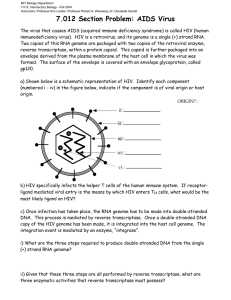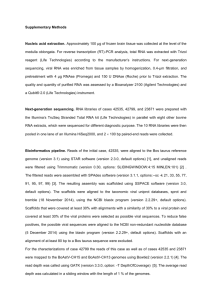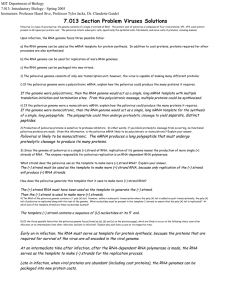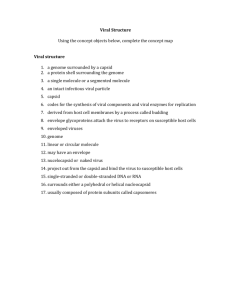MIT Department of Biology 7.013: Introductory Biology - Spring 2005
advertisement
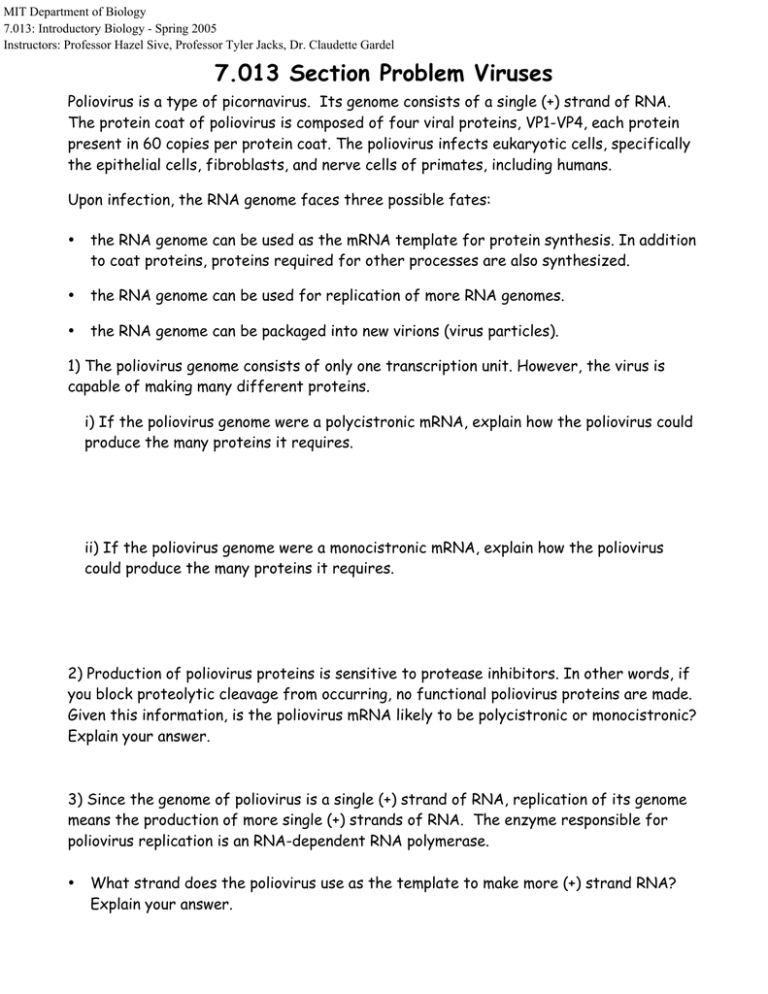
MIT Department of Biology 7.013: Introductory Biology - Spring 2005 Instructors: Professor Hazel Sive, Professor Tyler Jacks, Dr. Claudette Gardel 7.013 Section Problem Viruses Poliovirus is a type of picornavirus. Its genome consists of a single (+) strand of RNA. The protein coat of poliovirus is composed of four viral proteins, VP1-VP4, each protein present in 60 copies per protein coat. The poliovirus infects eukaryotic cells, specifically the epithelial cells, fibroblasts, and nerve cells of primates, including humans. Upon infection, the RNA genome faces three possible fates: • the RNA genome can be used as the mRNA template for protein synthesis. In addition to coat proteins, proteins required for other processes are also synthesized. • the RNA genome can be used for replication of more RNA genomes. • the RNA genome can be packaged into new virions (virus particles). 1) The poliovirus genome consists of only one transcription unit. However, the virus is capable of making many different proteins. i) If the poliovirus genome were a polycistronic mRNA, explain how the poliovirus could produce the many proteins it requires. ii) If the poliovirus genome were a monocistronic mRNA, explain how the poliovirus could produce the many proteins it requires. 2) Production of poliovirus proteins is sensitive to protease inhibitors. In other words, if you block proteolytic cleavage from occurring, no functional poliovirus proteins are made. Given this information, is the poliovirus mRNA likely to be polycistronic or monocistronic? Explain your answer. 3) Since the genome of poliovirus is a single (+) strand of RNA, replication of its genome means the production of more single (+) strands of RNA. The enzyme responsible for poliovirus replication is an RNA-dependent RNA polymerase. • What strand does the poliovirus use as the template to make more (+) strand RNA? Explain your answer. • How does the poliovirus generate this template that it uses to make more (+) strand RNA? 4) The RNA of the poliovirus genome contains a 3' poly (A) tail. However, unlike in eukaryotic transcription where the poly (A) tail is added on post-transcriptionally, the poly (A) tail of poliovirus is replicated along with the rest of the genome. What nucleotides must be present in the template (–) strand to ensure that the poly (A) tail is replicated? At which end of the template strand are these nucleotides located? 5) Of the three possible fates that the poliovirus genome faces (listed as (a), (b) and (c) on the previous page), which one is likely to occur at the following times: soon after infection; an intermediate time after infection; and late in infection? Explain why each fate occurs at its respective time. 7.013 Section Problem: AIDS Virus The virus that causes AIDS (acquired immune deficiency syndrome) is called HIV (human immunodeficiency virus). HIV is a retrovirus, and its genome is a single (+) strand RNA. Two copies of this RNA genome are packaged with two copies of the retroviral enzyme, reverse transcriptase, within a protein capsid. This capsid is further packaged into an envelope derived from the plasma membrane of the host cell in which the virus was formed. The surface of the envelope is covered with an envelope glycoprotein, called gp120. a) Shown below is a schematic representation of HIV. Identify each component (numbered i - iv) in the figure below, indicate if the component is of viral origin or host origin. ORIGIN? i) ii) iii) iv) v) b) HIV specifically infects the helper T cells of the human immune system. If receptorligand mediated viral entry is the means by which HIV enters TH cells, what would be the most likely ligand on HIV? c) Once infection has taken place, the RNA genome has to be made into double-stranded DNA. This process is mediated by reverse transcriptase. Once a double-stranded DNA copy of the HIV genome has been made, it is integrated into the host cell genome. The integration event is mediated by an enzyme, “integrase”. i) What are the three steps required to produce double-stranded DNA from the single (+) strand RNA genome? ii) Given that these three steps are all performed by reverse transcriptase, what are three enzymatic activities that reverse transcriptase must possess? In recent years, therapies have been developed to fight AIDS using nucleotide analogs. The drug most widely used to combat AIDS is Azidothymine (AZT). The structure of AZT is very similar to thymidine except that in AZT, the 3'-hydroxyl (OH) group on the deoxyribose ring has been replaced by an azido (N3) group. d) Which process of the life cycle of the HIV do you think is inhibited by AZT? e) What other phase in the HIV life cycle may be more appropriate to disrupt, one that won't likely affect host cellular processes? Explain your answer. AZT resistant forms of HIV have been isolated. These mutant viruses have mutations in one of the genes of the virus that result in resistance to AZT. f) In which viral gene do you think are the mutations most likely to be found? Explain. g) Starting with the virus in the bloodstream, order the following steps in the life cycle of HIV. A- Entry of the viral genome into the nucleus. B- Adsorption of the viral proteins to cell-surface receptors. C- Degradation of DNA-associated viral RNA. D- Fusion of the viral membrane with the plasma membrane. E- DNA-dependent RNA synthesis. F- Integration of the viral nucleic acid into the host genome. G- Encapsidation of the viral genome into protein coats.
